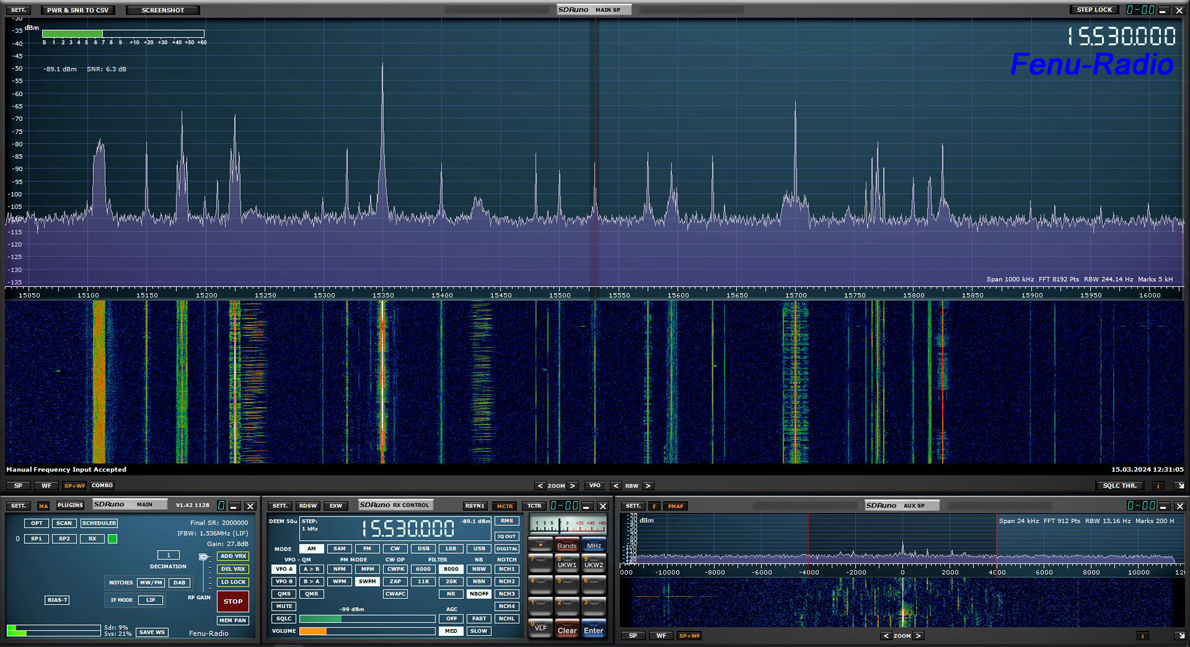|



SDRplay RSP1B
SDRplay has been a
well-known manufacturer and supplier of tuner-based SDR receivers
for several years. The devices are all manufactured in England,
where the company is also based. SDRplay receivers are becoming
increasingly popular with SWLs, radio amateurs and even professional
users. You can get devices with a huge frequency range, from 1KHz to
2GHz. With the right software, there are almost no limits. That is
why I would like to introduce you to the newest member of the
SDRplay family. The SDRplay RSP1B.
Strictly speaking, the RSP1B is the improved version of the RSP1A.
It has received a few important hardware updates that should help it
to achieve better reception. That made me curious. A good quality
wideband SDR that costs well under 160€?
I contacted Jon Hudson, the owner of SDRplay, and asked if he could
send me a test device. Would you believe it, less than 24 hours passed
and the RSP1B was on my desk. My compliments to SDRplay for the
speedy delivery!
Unpacking
The device comes in simple packaging, which also serves as the
operating instructions. Unfortunately, the device does not come with
a USB cable. This should be a type A to type B USB cable. You should
definitely get a well-shielded cable to avoid interference.
The housing
The first thing you notice is the metal housing. It is designed to
shield the sensitive electronics from interference. It leaves a good
impression. It is very sturdy, has a precise fit and the paintwork
is of good quality. The antenna connection in SMA standard is
located on the left-hand side. The USB-B port is located on the
right-hand side of the housing. I would have liked to have seen a
newer USB standard here. Such as the current USB-C standard. The
RSP1B stands on four rubber feet. The housing screws that hold the
upper and lower housing shells together are hidden under these feet.
I unscrewed the device to take a look inside. The circuit board is
not screwed separately to the housing. It is clamped between the
upper and lower housing shells by the screws. I noticed something
here that is marked with red arrows in the picture below. The
receiver board is clamped between eight support surfaces. Two of the
four supports on the lower housing shell have been kept bare at the
factory in order to establish an earth connection to the circuit
board. Unfortunately, all the other supports, especially those on
the upper housing shell, are not bare at the contact points. There
are paint residues on them that prevent good ground contact. This
can lead to the housing not shielding properly! The screw head
contact surface was also painted over, which prevents ground contact.
I removed the paint from all the supports before screwing them
together to ensure clean ground contact. This way I can be sure that
the metal housing really achieves its shielding effect.
The
receiver board
Pictures say more than words! The circuit board is very cleanly
constructed. Of course it was assembled by machine.
Sad but true... I had searched in vain for a block diagram on the
SDRplay website to explain the signal path of the RSP1B here. After
contacting Jon Hudson, I found out that SDRplay no longer provides
block diagrams and detailed information on the components of the
devices. The reason for this is product piracy! I fully understand
SDRplay's approach.
|
The
most important key data of the RSP1B
-- Frequency range: 1KHz - 2000MHz continuous
-- Low pass filter up to 2MHz
-- Bandpass filter for shortwave: 2-12, 12-30, 30-60MHz
-- Bandpass filter for VHF. UHF, SHF: 60-120, 120-250,
250-300, 300-380, 380-420, 420-1000MHz
-- High-pass filter from 1000-2000MHz
-- Switchable cut filters for MW, FM and DAB+
-- Built-in and switchable remote power supply with
4.7V/100mA
-- Sensitivity: approx. 0.15uV
-- ADC: 14bit max. (depending on the sampling rate)
-- Stabilized TCXO with 0.5ppm
-- SMA antenna connector for all frequency ranges
-- USB-B connection
-- Operating voltage 5V (via USB socket)
-- Operating modes: AM, SAM, LSB, USB, CW, FM, WFM, DRM,
DAB+, Digital or software-dependent & depending on plugin
-- Spectrum bandwidths with SDRuno: up to max. 10MHz
-- Dimensions: 98x94x35mm (WxDxH)
-- Weight: 315g
-- Scope of delivery: RSP1B, short installation instructions
on the box
|
The software
The software that SDRplay provides free of charge for its SDRs is
called "SDRuno". For some time now there has also been "SDR Connect",
which comes from the same company. This software is very promising,
still "preview" but fully functional. Therefore, all
tests were carried out with SDRuno & SDR Console-V3.
Here is an overview of the programs that can control the RSP1B.
--
SDRuno
--
SDR Connect
--
SDR Console V3
--
HDSDR
(ExtIO.dll download
here)
--
SDR++
(not yet fully
compatible at the time of testing)
Comparisons
Changes have been made to the hardware of the RSP1B which should
significantly improve reception in the lower frequency range, i.e.
in the VLF, long wave and medium wave range. Shortwave reception and
the VHF range should also benefit from this. I got to the bottom of
this and compared the RSP1B with the Elad FDM-S3.
The following antennas were used:
- Stampfl X-One (horizontal polarization)
- Datong AD370 / AD370-R (horizontal polarization)
- NTi Megadipol MD300DX (vertical polarization)
Reception on VLF
After many comparative tests at different times of day, a clear
increase in the performance of the RSP1B in the VLF range is
noticeable. Reception is usually as good as with the Elad-S3. The
sensitivity of the RSP1B is practically on a par with the S3. There
are hardly any audible differences. Only in the evening hours did
the RSP1B occasionally exhibit signs of clipping. This manifested
itself in a higher background noise level.
Audio comparisons
Second 0 - 10: SDRplay RSP1B
Second 10 - 20: Elad-S3
Some audio comparisons are intentionally close to the noise floor in
order to test sensitivity and intelligibility under difficult
conditions. Headphones should be used to hear the small differences
in the audio comparisons.
During the day, reception on VLF frequencies is attenuated due
to propagation conditions.
That's why I made these comparisons during the day. At night, the
signal strengths in this frequency range are much stronger and pose no
challenge. The reception performance of the RSP1B is practically at
the same level as that of the Elad-S3. I used the SDR Console-V3 for
the visual comparison test on VLF and LW because the spectrum/waterfall
can be set identically for both receivers. The active dipole Stampfl
X-One and the MegaDipol MD300DX were used for these comparisons.
Alpha-Navigation-RUS -
14.9khz
Mode: CW
BW: 500Hz
 |
Military-RUS -
18.1khz
Mode: CW
BW: 150Hz
 |
Timesignal
MSF-GBR - 60khz
Mode: CW
BW: 150Hz
 |
Timesignal
RBU-RUS - 66.66khz
Mode: CW
BW: 750Hz
 |
Timesignal
DCF77-DEU - 77.5khz
Mode: CW
BW: 150Hz
 |
Just
in time for Easter: reception of the Alpha navigation signals at 3pm
in the afternoon. This could only be received with the MegaDipol
MD300DX because it is vertically polarized.
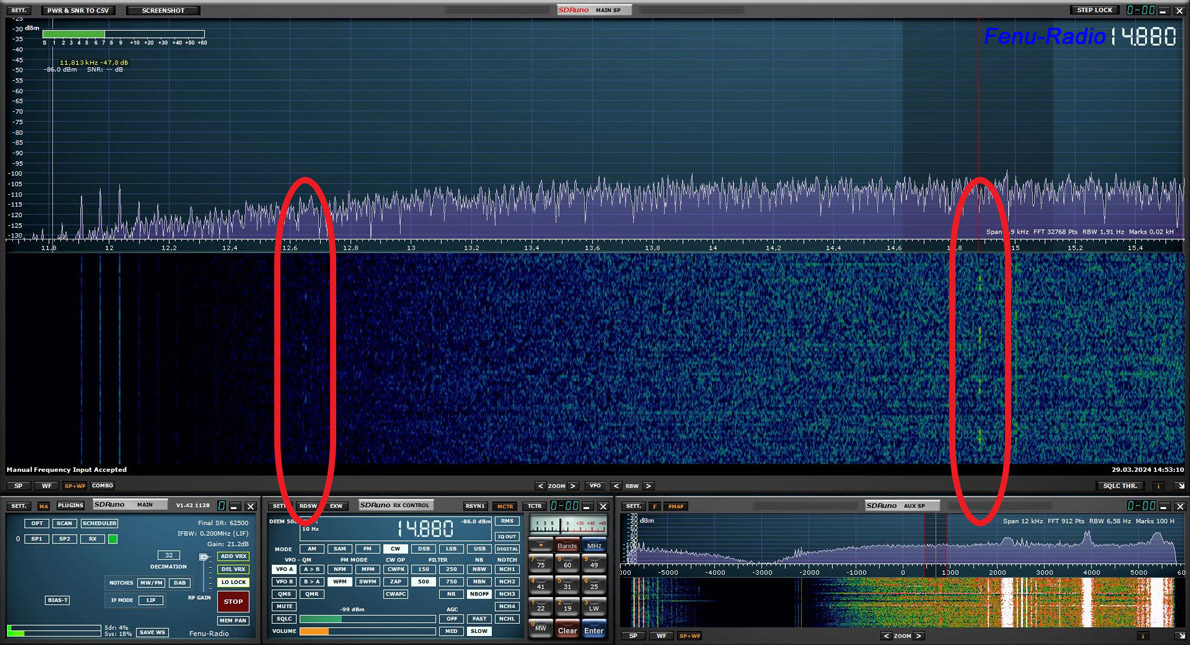
Below: Reception of the time signal transmitter RBU from Moscow at
5pm in the afternoon. Can only be received with the MegaDipol
MD300DX because it is vertically
polarized.
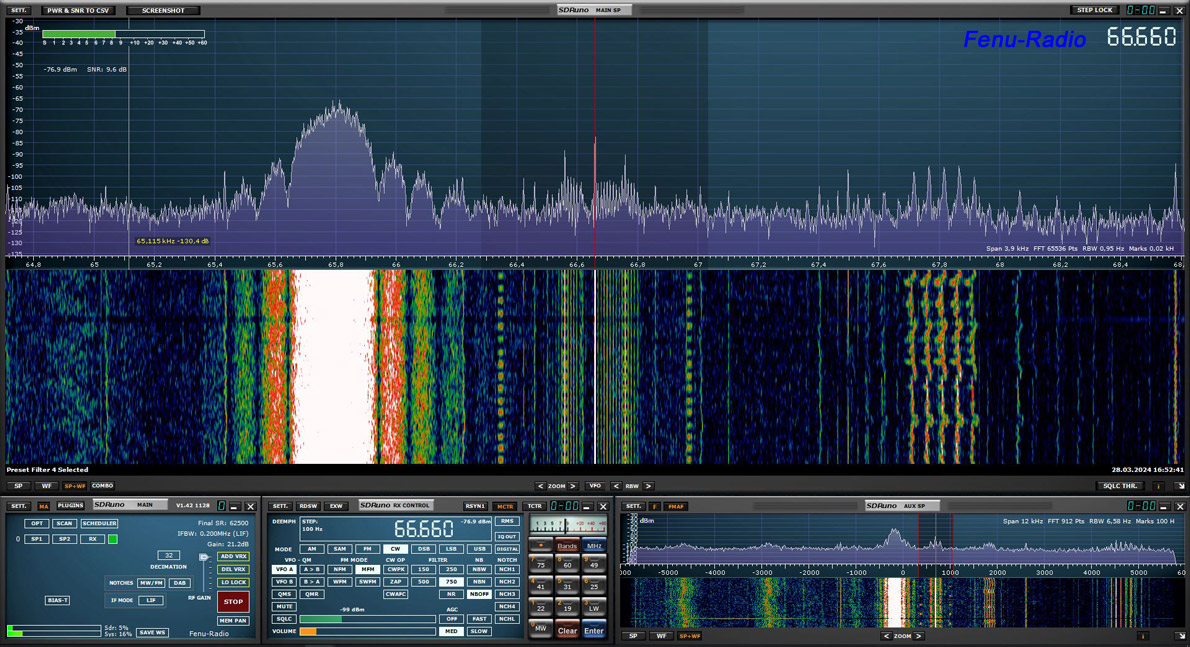
VLF range 10KHz - 90KHz
Both competitors at the same time. The important SNR is slightly
better with the S3!
Click on the diagram below to enlarge
it.

Reception on longwave
Unfortunately, fewer and fewer stations are broadcasting on long
wave. Where I live, only the usual stations can still be heard. Here,
too, I made the recordings during the day. Antenna: Stampfl X-One &
AD370-R
Antena
Satelor - 153khz
Mode: SAM
BW: 8KHz
 |
Medi 1-MRC -
171khz
Mode: SAM
BW: 8KHz
 |
BBC 4-GBR -
198khz
Mode: SAM
BW: 8KHz
 |
Longwave range
70KHz - 270KHz
Click on the diagram below
to enlarge it.

Reception on medium wave
Listening on medium wave was a pleasant experience. During several
test sessions, I was unable to detect any unwanted signals or
clipping effects. The SDRuno offers direct access to predefined
radio or amateur radio bands with the practical band buttons. This
includes the medium wave. This function automatically sets the
medium wave band to its full width with "LO Lock" tuning. This means
that the local oscillator frequency is fixed. When tuning the
frequency, the bandwidth bar is moved and not the spectrum/waterfall.
Radio Caroline -
648khz
Mode: SAM
BW: 8KHz
 |
Danko
Radio-HNG - 1116khz
Mode: SAM
BW: 9KHz
 |
Radio Studio
X-ITA - 1188khz
Mode: SAM
BW: 8KHz
 |
Below: Full-width medium wave at 8pm
on the Datong AD370 active dipole. Nice clean reception! As usual
with multiple assignments that make listening difficult. Below is
the 648Khz on which Radio Caroline broadcasts.
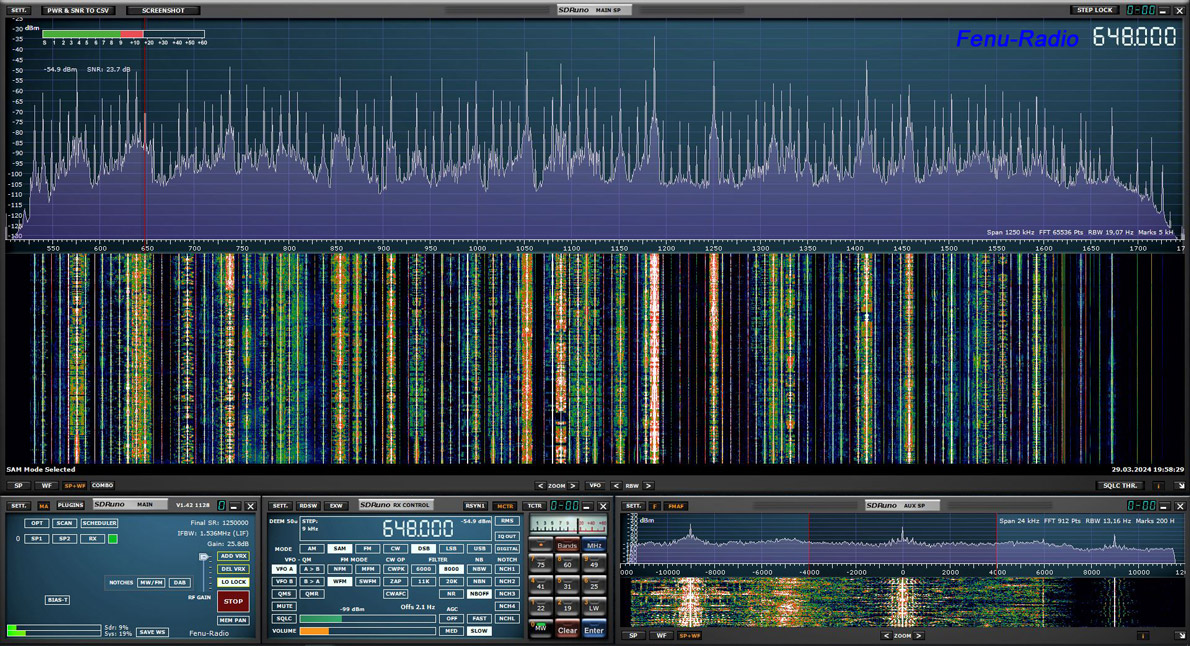
Reception on shortwave
A well-balanced receiver/antenna combination is the prerequisite
for good reception! Of course, the location should be as free of
interference as possible. The RSP1B performs well on shortwave! Not
very well, because its inadequate preselection sets limits. The
shortwave is not filtered well enough. The two built-in bandpass
filters (2-12 & 12-30MHz) are simply not enough. Even if the sum
signals are not excessively strong, you can hear and see
intermodulation below 15MHz in the evening hours. The sensitivity on
shortwave is sufficiently good and can keep up with the premium SDR
Elad-S3. Very good to hear in the audio example "RAF Volmet". A
signal at the limit of intelligibility.
Timesignal CHU-CAN -
3330khz
Mode: USB
BW:2.8KHz
 |
Hamradio 80m-CHE - 3681KHz
Mode: LSB
BW: 2.8KHz
 |
HCJB-DEU - 3995khz
Mode: SAM
BW: 6KHz
 |
Shannon Volmet-IRL - 5505khz
Mode: USB
BW: 2.8KHz
 |
Pirate Station-NLD -
6290khz
Mode: SAM
BW: 8KHz
 |
Bangkok Volmet - 8743khz
Mode: USB
BW: 2.8KHz
 |
RAF Volmet-GBR
11253khz
Mode: USB
BW: 2.8KHz
 |
R. N. da
Amazonia-BRA - 11780khz
Mode: SAM-U
BW: 4KHz
 |
Timesignal
CHU-CAN - 14670khz
Mode: USB
BW: 2.8KHz
 |
Bake
DK0TEN-DEU - 28257khz
Mode: CW
BW: 150Hz
 |
Below:
Maximum bandwidth of 10MHz for the first check before zooming into
the detail. The resolution of the spectrum is up to 0.95Hz depending
on the viewing width!
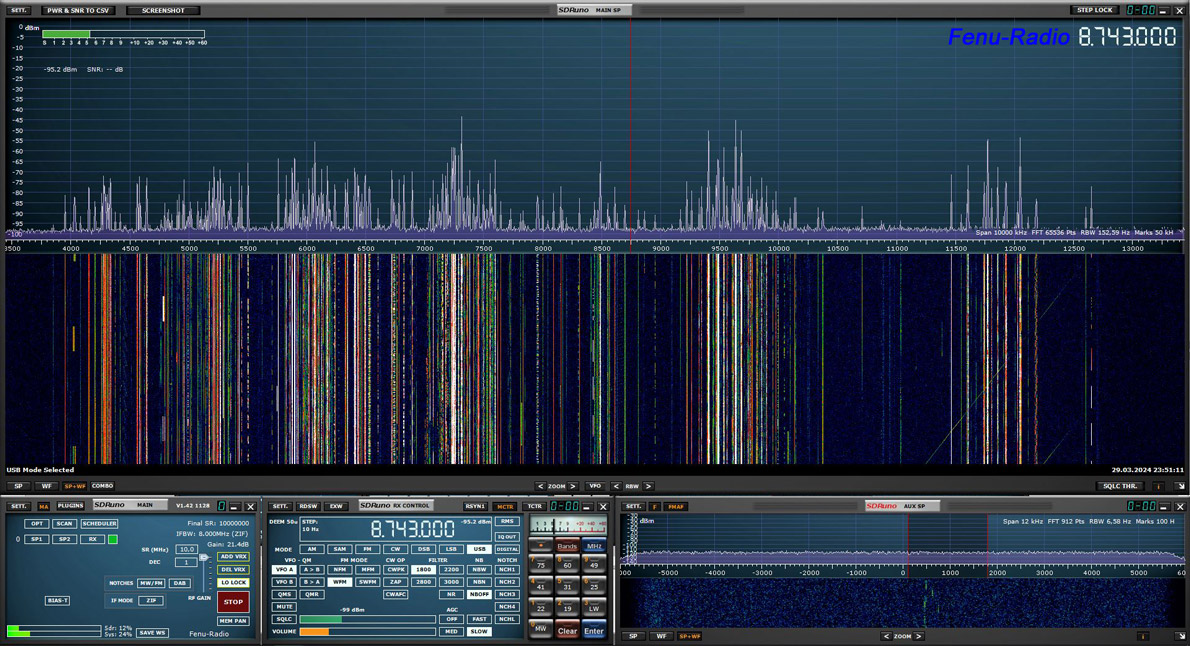
Reception on FM
I haven't done any detailed tests and comparisons above shortwave.
This is not my hunting ground. In addition, there is hardly any
radio traffic to be received above 135 MHz where I live.
In the VHF and lower VHF range, I only noticed minor irregularities.
The RSP1B works best with the Stampfl X-One active dipole up to
above the airbband. This antenna does not have too high a level and
has little noise. This suits the RSP1B very well. It only produces a
few intermodulation products. In direct comparison with the Elad-S3,
the differences are small. Sometimes the SDRuno software performs
slightly better than the Elad software. For example, the RDS decoder.
This decodes much faster and the sound was sometimes more pleasant.
The latter is of course a matter of taste.
SRF1-CHE - 94.4MHz
Mode: WFM
BW: 160KHz

FM range 90MHz - 100MHz
Click on the diagram below to
enlarge it.

Reception in the airband
Civil aviation radio is still an interesting field of activity
for many SWLs. The RSP1B is also suitable for this. The differences
to the S3 with its downconverter are minor. The very good scanner
function of SDRuno can be used particularly well here.
Volmet ZRH-CHE - 127.2MHz
Mode: AM
BW: 8KHz

Airband range 130MHz - 137MHz
Click on the diagram below
to enlarge it.

DAB+ reception and other options
Thanks to the SDRuno software, the RSP1B can also receive and decode
DAB+. This is possible with a free plug-in, which is included in the
SDRuno package. DRM, Navtex, RTTY, Acars etc. can also be received
with other free plug-ins. However, some plugins are not fully
developed and cause a high CPU load or SDRuno hangs. What has worked
well is DAB+.
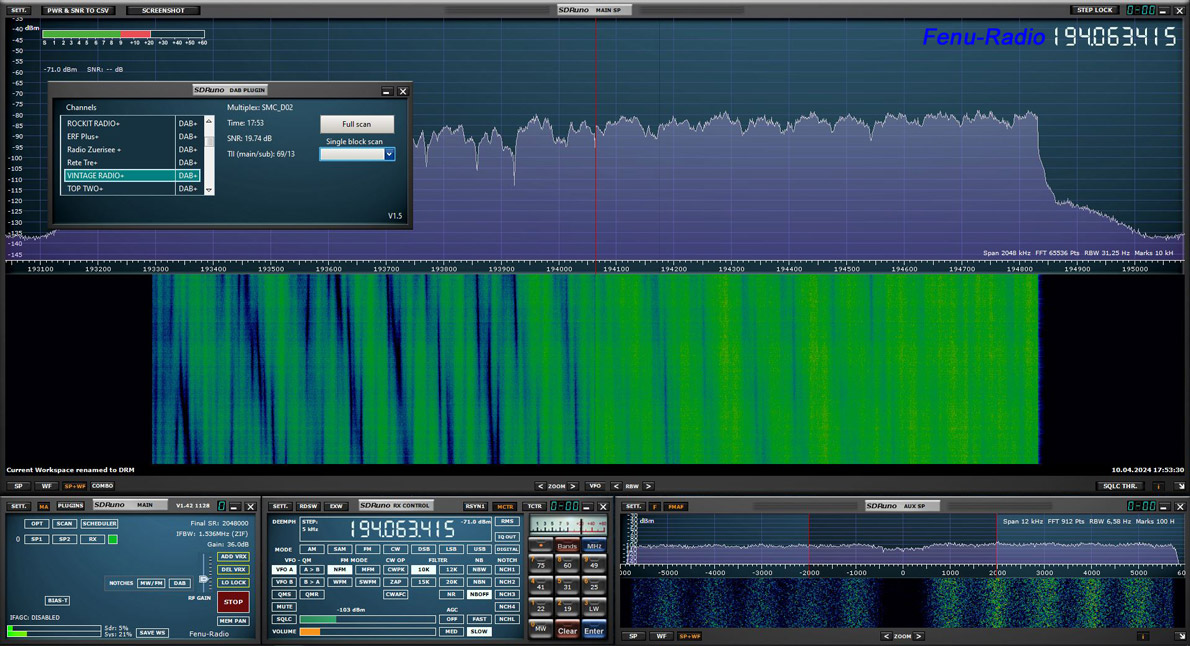
Conclusion:
SDRplay has not promised too much. The performance in the lower
frequency ranges is impressive and is practically on a par with the
Elad FDM-S3. The RSP1B is also largely convincing on shortwave. The
sensitivity is not at the highest level, but at a good level. It is
sufficient to keep up with the S3. The Achilles heel of the RSP1B is
the lack of preselection on shortwave. Intermodulation is often a
companion on an evening foray into shortwave. This is where the
Stampfl X-One active dipole has proven to be the ideal antenna for
the RSP1B. Due to its not too high level, it is very suitable up to
150MHz.
It would have been nice if SDRplay had paid more attention to the
finish of the metal housing. Important contact points were painted
over and could therefore impair the shielding effect of the metal
housing.
The RSP1B works best with the SDRuno software and also offers the
widest range of functions, leaving almost nothing to be desired.
For the reasonable price of less than 160€, the RSP1B can do almost
everything and the hardware is good quality to boot”
Source of supply:
SDRplay
postet: 13.04.2024



|

.jpg)

.jpg)

.jpg)

.jpg)
.jpg)

.jpg)

.jpg)
.jpg)
.jpg)
.jpg)

.jpg)


